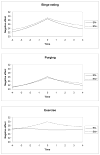Trait-level and momentary correlates of bulimia nervosa with a history of anorexia nervosa
- PMID: 22987478
- PMCID: PMC3570735
- DOI: 10.1002/eat.22054
Trait-level and momentary correlates of bulimia nervosa with a history of anorexia nervosa
Abstract
Objective: Some investigators have suggested subtyping bulimia nervosa (BN) by anorexia nervosa (AN) history. We examined trait-level and momentary eating-related and psychosocial factors in BN with and without an AN history.
Method: Interview, questionnaire, and ecological momentary assessment data of eating-related and psychological symptoms were collected from 122 women with BN, including 43 with (BN+) and 79 without an AN history (BN-).
Results: Body mass index (kg/m(2) ) was lower in BN+ than BN- (p = 0.001). Groups did not differ on trait-level anxiety, shape/weight concerns, psychiatric comorbidity, or dietary restraint; or on momentary anxiety, dietary restriction, binge eating, purging, or exercise frequency, or affective patterns surrounding binge/purge behaviors. Negative affect increased prior to exercise and decreased thereafter in BN+ but not BN-, although groups did not statistically differ.
Discussion: Results do not support formally subtyping BN by AN history. Exercise in BN+ may modulate negative affect, which could have important treatment implications.
Copyright © 2012 Wiley Periodicals, Inc.
Figures

Similar articles
-
Affective processes underlying restrictive eating in atypical anorexia nervosa: Comparisons to anorexia nervosa and bulimia nervosa using ecological momentary assessment.Int J Eat Disord. 2024 Apr;57(4):879-891. doi: 10.1002/eat.24134. Epub 2024 Jan 8. Int J Eat Disord. 2024. PMID: 38192012
-
Bulimia nervosa-nonpurging subtype: closer to the bulimia nervosa-purging subtype or to binge eating disorder?Int J Eat Disord. 2014 Apr;47(3):231-8. doi: 10.1002/eat.22218. Epub 2013 Nov 26. Int J Eat Disord. 2014. PMID: 24282157 Clinical Trial.
-
Dietary Restriction Behaviors and Binge Eating in Anorexia Nervosa, Bulimia Nervosa and Binge Eating Disorder: Trans-diagnostic Examination of the Restraint Model.Eat Behav. 2015 Aug;18:192-6. doi: 10.1016/j.eatbeh.2015.05.012. Epub 2015 Jun 10. Eat Behav. 2015. PMID: 26122390 Free PMC article.
-
Towards a physiologically based diagnosis of anorexia nervosa and bulimia nervosa.Expert Rev Mol Diagn. 2007 Nov;7(6):845-57. doi: 10.1586/14737159.7.6.845. Expert Rev Mol Diagn. 2007. PMID: 18020913 Review.
-
Validity and utility of subtyping anorexia nervosa.Int J Eat Disord. 2009 Nov;42(7):590-4. doi: 10.1002/eat.20717. Int J Eat Disord. 2009. PMID: 19598270 Free PMC article. Review.
Cited by
-
Validity and clinical utility of the DSM-5 severity specifier for bulimia nervosa: results from a multisite sample of patients who received evidence-based treatment.Eur Arch Psychiatry Clin Neurosci. 2017 Dec;267(8):823-829. doi: 10.1007/s00406-016-0712-7. Epub 2016 Jul 19. Eur Arch Psychiatry Clin Neurosci. 2017. PMID: 27435722
-
Associations of borderline personality disorder traits with stressful events and emotional reactivity in women with bulimia nervosa.J Abnorm Psychol. 2017 Jul;126(5):531-539. doi: 10.1037/abn0000225. J Abnorm Psychol. 2017. PMID: 28691843 Free PMC article.
-
Negative Affect as a Mediator Between Exposure to Fitspiration and Thinspiration and Disordered Eating Behaviors: An Ecological Momentary Assessment Study.Int J Eat Disord. 2024 Dec;57(12):2504-2515. doi: 10.1002/eat.24291. Epub 2024 Sep 26. Int J Eat Disord. 2024. PMID: 39323381
-
Ecological momentary assessment of stressful events and negative affect in bulimia nervosa.J Consult Clin Psychol. 2014 Feb;82(1):30-9. doi: 10.1037/a0034974. Epub 2013 Nov 11. J Consult Clin Psychol. 2014. PMID: 24219182 Free PMC article.
-
Binge-eating disorder with and without lifetime anorexia nervosa: A comparison of sociodemographic and clinical features.Int J Eat Disord. 2023 Feb;56(2):428-438. doi: 10.1002/eat.23858. Epub 2022 Nov 29. Int J Eat Disord. 2023. PMID: 36448187 Free PMC article.
References
-
- Fairburn CG, Harrison PJ. Eating disorders. Lancet. 2003;361:407–416. - PubMed
-
- American Psychiatric Association. Diagnostic and Statistical Manual of Mental Disorders, text revision. Washington, DC: American Psychiatric Association; 2000.
-
- Fairburn CG. Eating disorders: The transdiagnostic view and the cognitive behavioral theory. In: Fairburn CG, editor. Cognitive behavior therapy and eating disorders. New York: The Guilford Press; 2008. pp. 7–22.
-
- Bulik CM, Sullivan PF, Fear J, Pickering A. Predictors of the development of bulimia nervosa in women with anorexia nervosa. J Nerv Ment Dis. 1997;185:704–707. - PubMed
-
- Eckert ED, Halmi KA, Marchi P, Grove W, Crosby R. Ten-year follow-up of anorexia nervosa: Clinical course and outcome. Psychol Med. 1995;25:143–156. - PubMed
MeSH terms
Grants and funding
LinkOut - more resources
Full Text Sources

